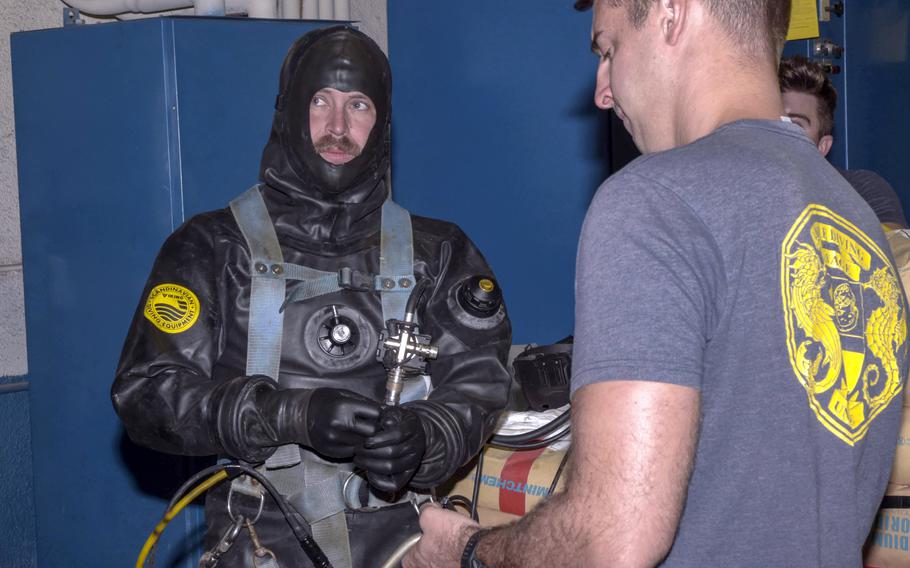
A Navy diver prepares to deploy a groundwater boom designed to prevent fuel contaminants from entering the pump system at the Red Hill well on the outskirts of Honolulu in January 2022. (Stephanie Butler/U.S. Navy)
HONOLULU — Navy Chief Petty Officer Brian Jessup was bathing his 10-month-old son at their Honolulu home in November 2021 when his wife called from work with an urgent plea: Don’t use the tap water.
“She was very concerned, panicked,” Jessup, a special operations diver who retired from the Navy last year, testified in Hawaii federal court Thursday.
His wife, Sheena Jessup, said customers had been telling her that the Navy’s water system for housing on and around Joint Base Pearl Harbor-Hickam was contaminated.
Jessup and his daughter, Breanna, 16, testified via Zoom in Feindt vs. United States, a civil suit that came to trial Monday in Hawaii U.S. District Court.
The suit filed by 17 plaintiffs seeks compensation for injuries arising from Navy tap water contaminated with jet fuel in late 2021 from the nearby Red Hill Bulk Fuel Storage Facility.
The lawsuit is the first of several filed in Honolulu stemming from water contamination at military housing in and around the joint base. U.S. District Court Judge Leslie Kobayashi is hearing the case without a jury.
Jessup testified that on that day in 2021 he whisked his son from the bath and then made certain none of his other three children were using water.
That call set off the family’s months-long saga, during which they underwent strange, new health problems, even as they used only bottled water to drink, cook and bathe for half a year.
In May 2022, his wife and children moved to Arizona and remained apart from Jessup for 10 months until he took an earlier-than-planned retirement.
Sheena Jessup and the four children are among the plaintiffs, which do not include any unformed service members. Brian Jessup is a plaintiff in a separate civil case filed last year on behalf of only active-duty members.
More than 7,500 additional plaintiffs have joined several other lawsuits also seeking compensation.
Bathing from saucepans
Many of the thousands of families affected by the contaminated water temporarily relocated to hotels for several months as the Navy sealed off the well and flushed the system.
The hotel room offered to the Jessups was not suitable for a family of six, as it had only two small beds and no Wi-Fi access that the children needed for their studies, Brian Jessup testified.
Instead, they continued to live in their Radford Terrace neighborhood, first using water distributed by the military and, when that ended, buying their own.
Fearful of using the tap water for showering or bathing, the family heated saucepans of water on the stove, then carried them to the bathroom to sponge off as best they could, Jessup said.
The entire family experienced symptoms they say arose from contact with the tainted water, he testified.
Among them were stomach pains, nausea, dizziness and headaches. Their eldest son, Beau, now 18, began experiencing tremors in his arms and hands soon after contamination, which has continued to worsen to this day, Jessup said.
Beau had planned to join the service and follow in his father’s footsteps, but that now seems unlikely because of his tremors, his father testified.
‘A lot of decisions’
“It was very difficult,” Breanna Jessup testified of the months following the contamination.
Bathing became an oppressive chore that altered the family’s routine, she said.
“You couldn’t go out as much,” she said. “You could go to the beach, but having sand all over your body, in your hair, salt water, it just took so much water to get it off you.”
After the Navy flushed the water system, Jessup said, she pleaded with her mother to let her finally take a proper shower with tap water.
“When I was done with the shower, I got burns, rashes on my arms,” she testified. “The ones that burned the most were on my forearms. The best way I could describe it is, have you ever been stung by a jellyfish? It kind of stings and burns at the same time.”
Brian Jessup testified that he decided that he had to send his family to Arizona, where his wife was raised.
“I had to make a lot of decisions I didn’t want to make right then,” he said.
He said the family could not afford to also rent him an apartment in Hawaii, so for months he slept on a cot in his office.
Happy, healthy lives
Brian Jessup said he and his wife agonize over the future.
“We’re very worried about our children,” he testified. “We want them to have long, happy, healthy lives. It’s common sense that when you’re exposed to these chemicals, there are going to be some repercussions to that.”
The government has acknowledged responsibility for the contamination but maintains that the Navy’s quick response prevented widespread and lengthy exposure by residents.
The lines of cross examination by government attorneys since the trial began Monday suggests their defense will assert that the cause of maladies experienced by residents was largely due to preexisting conditions and stress over the coronavirus pandemic.